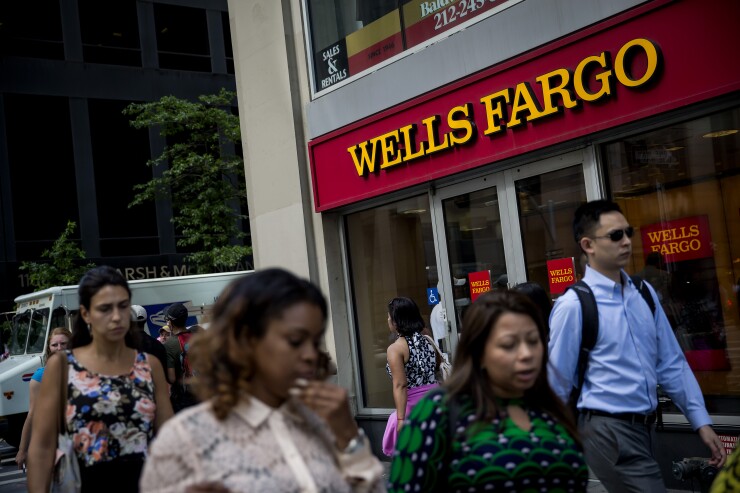There’s any number of reasons megabanks are rolling out mobile-first banking offerings, from evolving consumer demand to increased competition from fintechs to a significant generational transfer of wealth.
But the biggest motivation for banks like Wells Fargo to develop new smartphone apps may be to ensure they get clients early in their financial lives and keep them.
To that end, Wells Fargo has developed Greenhouse, a mobile banking account that delivers personal financial management insights to its users. (Wells’ investment arm, meanwhile, has
“It’s about helping people start in banking and doing it in the way that fits their lifestyle, and then as they grow, the services we have will grow and evolve around this segment,” said Steve Ellis, executive vice president and head of the Wells Fargo Innovation Group.
Wells has 22 million Generation X and millennial customers on its retail banking side with accounts or loans, according to the bank. Market trends, however, suggest that maintaining loyalty and expanding that base requires new tools.

Customers in their 20s are three times more likely to open a bank account on a phone than in a branch, and 67% say they want a bank to offer them digital budgeting tools, according to the American Bankers Association.
Similar to JPMorgan Chase’s
The PFM focus is designed to appeal to young customers managing rent payments and utilities bills for the first time, Ellis said. “We want to help them bring the money in and manage the money out and give them control of their financial lives in a quick and easy way, so they can really focus on being 20 years old and living life,” he said.
The app’s AI-driven advice will develop as clients build history, Ellis added.
“It will be analyzing inflows and outflows,” he said. “It will suggest things — if it sees things are going well, it will ask the customer to think about their savings account. If they are interested in investing, it will bring forward information to help educate them. We will be analyzing their data based on what they want us to do.”
Ellis acknowledged that personal finance apps have stumbled in the past because consumers found them difficult to remain engaged with. Wells will tailor the experience based on use, he said.
“Customer need and demand will drive priorities for how the Greenhouse experience evolves over the next few years,” he said, noting the possibility for it to add on lending and investing, even a tie-up with Intuitive Investor. “Since this service is for those who are new to banking, the user experience with the cash management piece is the first area of focus.”
Incumbent advantage
The Wells app enters a crowded market, as a number of fintechs and other banks have successfully launched mobile-only units.
In addition to JPMorgan’s Finn, there is
Fintechs such as Stash Invest have also launched bank accounts tied to a value-added service. Stash, a microinvestor,
Though the idea of digital-only banking isn’t innovative —
“The incumbents have a natural built-in advantage in their existing customer base, and the ennui that consumers have towards financial products,” Sokolin said. “If more consumers tried fintech solutions, they would like them. And consumers have positive impressions of the fintech brands they know. The real problem is that people generally do not know about the fintech companies — they may not love their incumbent bank, but at least they know about them.”

The big accomplishment of apps such as Acorns, Digit and Robinhood is that they have broken through into the mainstream by being less financial and more tech-oriented, Sokolin said.
“Their challenge is to rebundle the banking and investment product suite together so that when millennials want more than just auto-savings or PFM, they stay with the new brands. That's where Wells Fargo has the advantage. When someone using Greenhouse or [payments app] Zelle grows up to need a mortgage or a retirement portfolio, the integrated model is a natural fit,” Sokolin said.
Stash is confident it can hold its own against megabank competition, said CEO Brandon Krieg. The firm has more than 1.2 million subscribers and is growing at a rate of 25,000 a week. Over 60% of clients are millennials, he added.
“There are currently 109 million Americans who are considered underserved or overlooked by the traditional banks and incumbents,” Krieg said. “We learned more about what our clients need — and what they need is more help and guidance around all things money.
“Overall, the banks today are not totally aligned with what their customers need, they are not helping people save smarter, spend smarter and set themselves up for financial security,” he added.
Wells’ Ellis acknowledged the competition from other banks and fintechs.
“When I look at the fintechs — they’ve built products for people doing things in the moment that are simple and easy. They’ve done a really good job at that, and hats off to them for that. It’s a good idea for everyone to adopt.”





